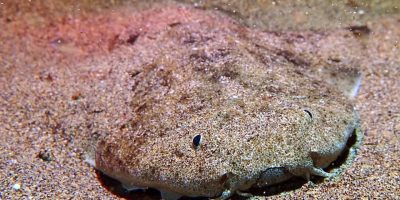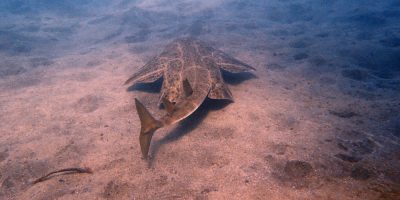Angel Shark
Have you been lucky enough to see one?
Interesting, weird looking and sadly now an endangered species, Angel sharks belong to the family of Squatinidae. These sharks have stretched-out bodies and wide pectoral fins that largely resembles with sting-rays. There are around 16 species that fall under the genus Squatina in the same family. Angel sharks inhabit all throughout the tropical and temperate waters of the world. One of these species is known to exist in deep waters at a depth of about 1,200m.
Angel sharks are not considered to be dangerous to humans but one should not approach them as they have a powerful bite force and pointed teeth.
Where do they live?
Angel sharks have an extensive distribution around the globe with species inhabiting across tropical waters to cold northern waters, and are often found in deep waters. Most of these species are active during the night and considered to be bottom-dwellers as they are known to prey on species that are
hidden under the sand with the help of their trap-like jaws. These species are best known to primarily feed on small bottom fish.
What do they eat?
They tend to camouflage themselves in sand patches, rocky areas or patch reefs during daytime. Some of the most common Angel sharks prey includes squid, small fish, octopus and crustaceans. These species are sit-and-wait predators and often prey on mollusks, croakers, hake, halibut, peppered shark, corbina, blacksmith, flatfish and other kinds of bony fish. They seldom take on invertebrates.
How do they reproduce?
According to the available data the mating of these species begins in summer season. The young sharks tend to develop inside the female mothers. The gestation period lasts for about 10 months and the usual births take place in the months of June and March. The females litter around 13– 20 pups which are 25cm long at birth.


General Information:
- The rear part of an Angel shark resembles a typical shark, whilst the mid-body resembles that of a sting-ray
- Their eyes and spiracles are located on the top of their body with five gills below
- They measure around 1.5 meters long
- These shark species are very fond of eating crustaceans, mollusks and fish
- Angel sharks are ovoviviparous and they give birth to 13 – 20 pups
- These sharks are harmless but as with all marine creatures, we should show respect as they can pose danger if provoked
- In 1980, Angel sharks provided an important food source especially for fisheries
- The largest Angel Shark recorded measured around 152 cm with the maximum age of 30 years
- Males become mature at 8 years and measure around 75cm – 80cm
- Females become mature at 13 years and measure around 90cm – 100cm
- There are white markings on an Angel shark’s body displaying different colours that range from bright brown to light grey, enabling them to camouflaged
Angel shark species
Sawback Angelshark
Clouded Angelshark
Eastern Angelshark
Ornate Angelshark
Ocellated Angelshark
Sand Devil Angelshark
Australian Angelshark
Chilean Angelshark
Japanese Angelshark
Indonesian Angelshark
Smoothback Angelshark
Western Angelshark
Argentine Angelshark
Pacific Angelshark
Gulf Angelshark
Mexican Angelshark
